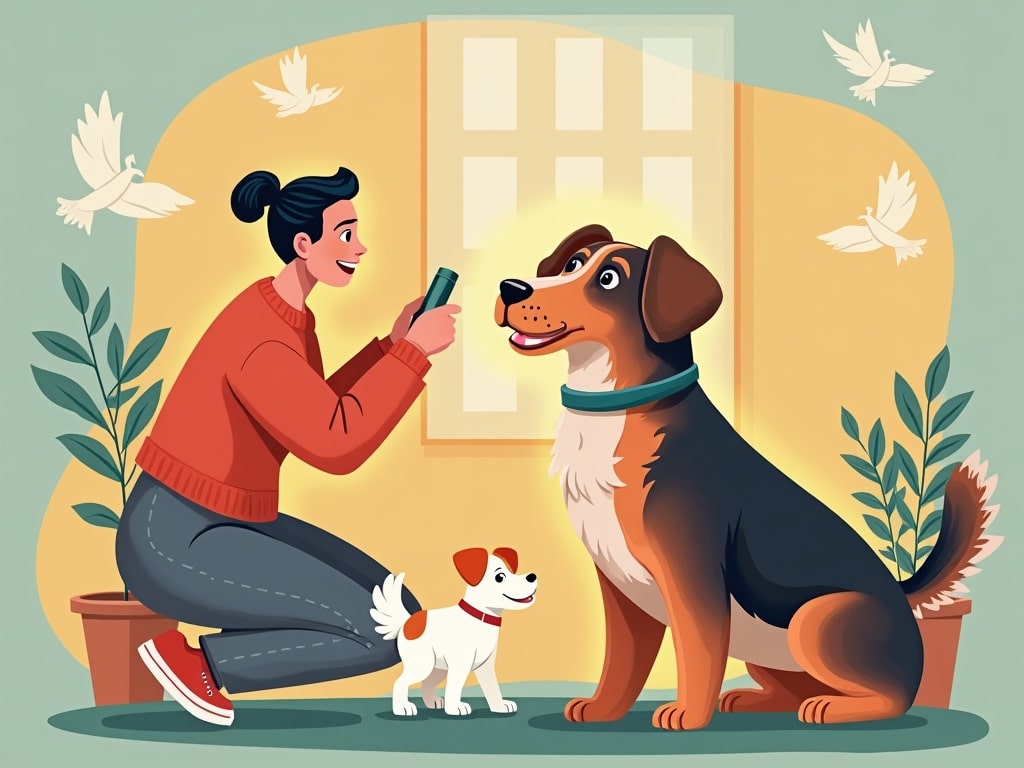How to Keep an Active Dog Calm Indoors: A Comprehensive Guide
Imagine this: you're settling in for a relaxing evening after a long day, but your high-energy dog has other plans. Leaping, barking, and generally turning your living room into an obstacle course, they seem determined to expel every last ounce of pent-up energy. Sound familiar? Many owners of active breeds face this daily challenge. The good news is, with the right strategies and a little patience, you can successfully teach your energetic companion how to chill out indoors.
Understanding Your Active Dog's Needs
Before diving into training techniques, it's crucial to understand why your dog is so restless. Active breeds like Border Collies, Huskies, Australian Shepherds, and Labrador Retrievers were bred for specific jobs that require a lot of physical exertion. Their energy levels are naturally high, and they need consistent outlets to prevent boredom and frustration.
- Breed Characteristics: Research your dog's breed to understand their inherent energy levels and exercise requirements.
- Age: Puppies and young dogs typically have more energy than older dogs.
- Individual Personality: Just like people, some dogs are naturally more energetic than others, regardless of breed.
- Environment: A stimulating environment with plenty of opportunities for play and exploration can help tire a dog out.
The Importance of Meeting Physical Needs
The foundation of a calm indoor dog is a well-exercised dog. If your dog hasn't had sufficient physical activity, expecting them to relax quietly inside is unrealistic.
Adequate Daily Exercise
Daily Walks or Runs: Tailor the length and intensity to your dog's breed and age. A brisk walk isn't always enough for high-energy breeds; consider runs, hikes, or bike rides.
Fetch: A classic game that provides excellent cardiovascular exercise and mental stimulation.
Dog Parks: Supervised playtime with other dogs can be a great way for your dog to burn energy and socialize.
Swimming: A low-impact exercise that's easy on the joints.
Beyond Traditional Exercise
Sometimes, traditional exercise isn't enough to fully satisfy an active dog. Incorporate activities that engage their minds as well as their bodies.
Agility Training: This involves navigating a course of obstacles, providing both physical and mental challenges.
Flirt Pole: A long pole with a lure attached that your dog chases. This is a great way to tap into their prey drive and expend energy quickly.
Weighted Vest: Use with caution and under veterinary guidance, a weighted vest can add resistance to walks, increasing the workout intensity. Start with a light weight and gradually increase it as your dog gets stronger.
Mental Stimulation: Tiring the Mind
Mental stimulation is just as important as physical exercise for calming an active dog. A bored dog is much more likely to exhibit destructive behaviors and restlessness. Here’s how to keep their minds engaged:
Puzzle Toys
Puzzle toys are a fantastic way to provide mental enrichment. These toys require your dog to figure out how to access the treats inside, keeping them entertained and focused.
Examples: Kong toys filled with frozen peanut butter, treat-dispensing balls, and complex puzzle toys with sliding compartments.
Training Sessions
Short, frequent training sessions are a great way to challenge your dog mentally and reinforce good behavior. Keep sessions positive and rewarding.
Basic Obedience: Practice commands like sit, stay, down, and come.
Trick Training: Teaching fun tricks like play dead or shake can be mentally stimulating and strengthen the bond between you and your dog.
Scent Work: Hide treats or toys and have your dog find them using their sense of smell.
Interactive Games
Engage your dog in interactive games that require them to think and problem-solve.
Hide-and-Seek: Hide treats or toys around the house and encourage your dog to find them.
Shell Game: Place a treat under one of several cups and have your dog guess which one it’s under.
Name Game: Teach your dog the names of their toys and ask them to retrieve specific ones.

Creating a Calm Indoor Environment
The environment in your home can significantly impact your dog's behavior. Creating a calm and relaxing space can help them settle down.
Designated Quiet Zones
Provide your dog with a comfortable and safe space where they can retreat when they need to relax.
Dog Bed or Crate: Make sure your dog has a comfortable bed or crate in a quiet area of the house.
Calming Aids: Consider using calming aids such as a pheromone diffuser or a white noise machine.
Limit Stimulation: Reduce visual and auditory stimulation by closing curtains or playing calming music.
Establishing a Routine
Dogs thrive on routine. A predictable daily schedule can help them feel secure and reduce anxiety.
Consistent Feeding Times: Feed your dog at the same times each day.
Regular Exercise Schedule: Stick to a consistent exercise routine.
Designated Rest Periods: Encourage your dog to rest at specific times of the day.
Teaching Relaxation Techniques
Train your dog to associate certain cues with relaxation.
Settle Command: Teach your dog to lie down and relax on their bed when you give the settle command.
Massage: Gently massage your dog to help them relax and release tension.
Calming Music: Play calming music specifically designed for dogs.
Addressing Problem Behaviors
Even with adequate exercise and mental stimulation, some dogs may still exhibit challenging behaviors indoors.
Jumping
Jumping is often a sign of excitement or seeking attention.
Ignore the Behavior: Turn your back and ignore your dog when they jump.
Reward Calm Behavior: Reward your dog when they have all four paws on the ground.
Teach an Alternative Behavior: Teach your dog to sit or lie down instead of jumping.
Barking
Excessive barking can be a sign of boredom, anxiety, or territoriality.
Identify the Trigger: Determine what is causing your dog to bark.
Desensitization: Gradually expose your dog to the trigger in a controlled environment.
Redirection: Redirect your dog's attention with a toy or command.
Chewing
Destructive chewing is often a sign of boredom or anxiety.
Provide Appropriate Chew Toys: Offer a variety of durable chew toys.
Dog-Proof Your Home: Remove items that your dog is likely to chew.
Supervise Your Dog: Keep an eye on your dog when they are indoors and redirect them when they start to chew on something inappropriate.
Tools and Aids for Calming
Certain tools and aids can be beneficial in helping your dog stay calm indoors.
Calming Supplements
- Melatonin: A natural hormone that can promote relaxation.
- L-Theanine: An amino acid that has calming effects.
- Herbal Remedies: Chamomile, valerian root, and passionflower are known for their calming properties.
*Consult with your veterinarian before using any supplements.
Anxiety Vests
Anxiety vests apply gentle, constant pressure, which can have a calming effect on some dogs.
Pheromone Diffusers
These diffusers release synthetic pheromones that mimic the natural pheromones produced by mother dogs, which can help reduce anxiety and promote relaxation.
Patience and Consistency
Training an active dog to be calm indoors takes time and consistency. Don't get discouraged if you don't see results immediately.
Be Patient: It takes time for dogs to learn new behaviors.
Be Consistent: Use the same commands and techniques consistently.
Stay Positive: Keep training sessions positive and rewarding.
When to Seek Professional Help
If you're struggling to manage your dog's energy levels or address problem behaviors, don't hesitate to seek professional help.
Veterinarian: A veterinarian can rule out any underlying medical conditions that may be contributing to your dog's behavior.
Certified Dog Trainer: A professional dog trainer can provide guidance on training techniques and behavior modification.
Veterinary Behaviorist: A veterinary behaviorist is a veterinarian who specializes in animal behavior and can diagnose and treat behavioral issues.
Conclusion
Keeping an active dog calm indoors requires a multifaceted approach that includes meeting their physical and mental needs, creating a calming environment, and addressing any problem behaviors. With patience, consistency, and the right strategies, you can help your energetic companion learn to relax and enjoy peaceful time indoors. So, take a deep breath, put these tips into action, and look forward to enjoying many calm and contented evenings with your four-legged friend.

